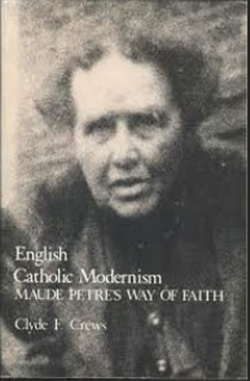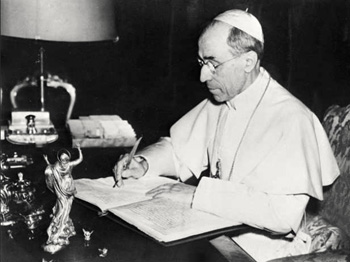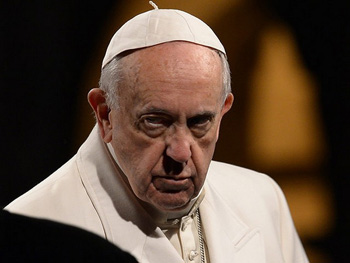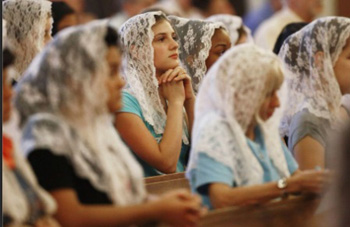Asuntos Tradicionalistas
 |
 |
 |
 |
 |
 |
 |
Misa de Diálogo - CXXVIII
La hermenéutica de la “rigidez” del Papa Francisco
Los artículos precedentes han proporcionado abundantes e irrefutables pruebas de que la acusación de “clericalismo” se ha convertido en una causa ideológica, sobre la que se han proyectado muchos de los prejuicios de los progresistas contra la Tradición. Habiendo comenzado como una objeción visceral al gobierno de los clérigos, el cargo (acusación) en sí mismo se ha convertido en la ideología dominante en la Iglesia del Vaticano II, ha sido iniciada, alimentada y mantenida por los clérigos.
 El principal de ellos fue, por supuesto, el P. George Tyrrell, sobre quien su amiga y protectora, Maude Petre, afirmó que “muchas, muchas son las cosas dichas abiertamente por católicos, sacerdotes o laicos, que nunca podrían haber sido dichas con seguridad si hombres como Tyrrell no las hubieran dicho primero, y hubieran sido decapitados por hacerlo.” (1) Ahora incluso los Papas están diciendo lo que dijo Tyrrell, y son los tradicionalistas los que han sido decapitados.
El principal de ellos fue, por supuesto, el P. George Tyrrell, sobre quien su amiga y protectora, Maude Petre, afirmó que “muchas, muchas son las cosas dichas abiertamente por católicos, sacerdotes o laicos, que nunca podrían haber sido dichas con seguridad si hombres como Tyrrell no las hubieran dicho primero, y hubieran sido decapitados por hacerlo.” (1) Ahora incluso los Papas están diciendo lo que dijo Tyrrell, y son los tradicionalistas los que han sido decapitados.
'Rigidez' y la 'Nueva Moralidad'
De todos los eslóganes burlones en el arsenal de insultos de Francisco contra los tradicionalistas, la acusación de “rigidez” es el arma preferida más asociada con su pontificado. Incluso una mirada superficial al sitio web del Vaticano revela que la palabra "rigidez", como sus muchas críticas a los "Doctores de la Ley", es un estribillo recurrente en sus discursos y escritos, tanto que se ha asociado con su nombre. .
Puede ser una sorpresa, por lo tanto, encontrar que la "rigidez" como término de abuso lanzado por los progresistas contra los católicos que defienden la moral católica tiene una larga historia, que se remonta al p. Tyrrell y el primer movimiento modernista.
El Papa Pío XII, en su mensaje de radio de 1952, alertó a los educadores católicos que los promotores de lo que él denominó la “Nueva Moral” (también conocida como Ética de la Situación) acusaban a la Iglesia de predicar “casi exclusivamente y con excesiva rigidez (excessiva rigidità ), sobre la firmeza y la intransigencia de las leyes morales cristianas… en lugar de fomentar la ley de la libertad humana y del amor, e insistir en ella como una dinámica digna de la vida moral”. (2) El Papa recordó a los fieles que “la acusación de rigidez opresiva hecha contra la Iglesia por la ‘nueva moral’ ataca en realidad, en primer lugar, a la Persona adorable de Cristo mismo”.(3)
En un discurso más tarde en el mismo año, (4) Pío XII consideró vital que todos los fieles comprendieran el fundamento divino sobre el cual se establece la moral católica y la meta a la que apunta: la salvación de las almas. En particular, señaló la tendencia prevaleciente entre los católicos liberales de considerar a aquellos que tratan inflexiblemente de seguir la Ley de Dios como culpables de “l'hypocrisie d'une fidélité pharisaïque aux lois” (la hipocresía de los fariseos que observan meticulosamente las leyes.)
Será útil tener estos puntos en mente cuando examinemos algunas de las frecuentes ocasiones en que Francisco ha usado el término “rigidez” en el sentido reprobado por Pío XII.
La 'rigidez' Francisco y la 'Nueva Moralidad'
En manos del Papa Francisco, la rigidez es una palabra que no se puede precisar en una definición clara. Su elusividad es precisamente lo que lo hace valioso como término propagandístico. Puede significar lo que él desee que signifique en cualquier circunstancia que elija. Por lo general, lo usa para transmitir una sensación de furia (señal Tyrrell) contra la Tradición. Aquí veremos cómo lo usa como un insulto general para casi todo lo que le molesta de los tradicionalistas.
 Su breve es fijo e inmutable, basado en la intolerancia hacia cualquiera que cuestione las reformas del Vaticano II. De hecho, difícilmente se puede pensar en algo más rígido, o despiadado, que su propia oposición implacable al catolicismo tradicional. Ahora ha respaldado abiertamente la erradicación de la Tradición por completo al ordenar a los obispos del mundo que limiten la celebración de la misa tradicional en latín con miras a su extinción, y que prohíban el uso de los sacramentos anteriores al Vaticano II.
Su breve es fijo e inmutable, basado en la intolerancia hacia cualquiera que cuestione las reformas del Vaticano II. De hecho, difícilmente se puede pensar en algo más rígido, o despiadado, que su propia oposición implacable al catolicismo tradicional. Ahora ha respaldado abiertamente la erradicación de la Tradición por completo al ordenar a los obispos del mundo que limiten la celebración de la misa tradicional en latín con miras a su extinción, y que prohíban el uso de los sacramentos anteriores al Vaticano II.
De aquí se deduce que, para el Papa Francisco, no todas las “rigideces” son iguales: unas, aparentemente, son más iguales que otras.
Las rigideces inaceptables
Cuando examinamos los casos en los que Francisco usa el adjetivo “rígido” como un término de abuso, no podemos dejar de notar que siempre se dirige contra los católicos que se niegan a abandonar la fe de sus antepasados espirituales. No se puede negar la profunda antipatía con la que ve a estos fieles miembros de la Iglesia: son, a sus ojos, condenados por los siguientes crímenes "clericalistas": La naturaleza abiertamente revolucionaria y profundamente filistea de esta posición es innegable. Está en consonancia con los defensores de “Cancelar la cultura”, a quienes les encanta avergonzar a los virtuosos y promover la inmoralidad como algo normal. Es como si Francisco animara a los fieles a amar el pecado y odiar el bien.
La naturaleza abiertamente revolucionaria y profundamente filistea de esta posición es innegable. Está en consonancia con los defensores de “Cancelar la cultura”, a quienes les encanta avergonzar a los virtuosos y promover la inmoralidad como algo normal. Es como si Francisco animara a los fieles a amar el pecado y odiar el bien.
En este artículo y en el siguiente, veremos cómo el Papa Francisco sigue mostrándose malévolo con aquellos que intentan defender las doctrinas y los preceptos enseñados por la Iglesia. Al desviarse persistentemente de lo que siempre se ha considerado normal, Francisco ha llevado al resultado perverso de que derrotar la Fe de todos los siglos cristianos ahora se identifica con la virtud. De hecho, cualquiera que escuche sus frecuentes ataques a la "rigidez" podría fácilmente tener la impresión de que el camino al infierno está pavimentado con fervor moral.
¿Quiénes son los intolerables “tipos rígidos” de los que habla Francisco?
La respuesta corta es cualquiera que se oponga a su agenda progresista. La más largo, desarrollada por el propio Francisco, se centra en los sospechosos habituales, aquellos que se niegan a seguir la Revolución y muestran las siguientes características:
“Inflexibilidad hostil, es decir, querer encerrarse en la palabra escrita, (la letra) y no dejarse sorprender por Dios, por el Dios de las sorpresas, (el espíritu); dentro de la ley, dentro de la certeza de lo que sabemos y no de lo que aún nos falta aprender y lograr. Desde el tiempo de Cristo, es la tentación de los celosos, de los escrupulosos, de los solícitos y de los llamados –hoy– “tradicionalistas” y también de los intelectuales”. (5)
Desde el comienzo de su pontificado (las palabras anteriores fueron escritas en 2014), Francisco ha estado creando estereotipos negativos sobre los católicos “rígidos”, es decir, aquellos que se mantienen firmes en principios que no son negociables. Aquí, los acorrala en un grupo para que puedan ser catalogados colectivamente como extremistas, de mente cerrada, de corazón duro, con problemas psicológicos e incapaces de mantenerse al día. Confesó querer tirarles una cáscara de plátano a sus pies como remedio a su supuesta soberbia y “rigidez”, “para que caigan bien y sientan vergüenza de ser pecadores”(6).
Podemos estar seguros de que el chiste de la cáscara de plátano no se hizo con buen humor, ya que desde entonces, Francisco ha estado librando una guerra implacable contra los tradicionalistas; los ha estigmatizado y marginado persistentemente y les ha dificultado el acceso a los ritos tradicionales. En resumen, ha preparado el escenario para el rechazo y la persecución de los católicos tradicionales.
No hay tiempo para los jóvenes tradicionalistas "rígidos".
Francisco ha expresado su incredulidad ante la popularidad de la misa y los sacramentos tradicionales en latín entre la nueva generación de jóvenes de hoy, más de medio siglo después de la imposición del Novus Ordo Missae:
 “Me pregunto sobre esto. Por ejemplo, siempre trato de entender qué hay detrás de las personas que son demasiado jóvenes para haber vivido la liturgia preconciliar pero que la quieren. A veces me he encontrado frente a personas demasiado estrictas, que tienen una actitud rígida. Y yo me pregunto: ¿A qué viene tanta rigidez? Cava, cava, esta rigidez siempre esconde algo: inseguridad, a veces más… La rigidez es defensiva. El verdadero amor no es rígido.” (7)
“Me pregunto sobre esto. Por ejemplo, siempre trato de entender qué hay detrás de las personas que son demasiado jóvenes para haber vivido la liturgia preconciliar pero que la quieren. A veces me he encontrado frente a personas demasiado estrictas, que tienen una actitud rígida. Y yo me pregunto: ¿A qué viene tanta rigidez? Cava, cava, esta rigidez siempre esconde algo: inseguridad, a veces más… La rigidez es defensiva. El verdadero amor no es rígido.” (7)
La atracción de los jóvenes por la misa tradicional es un fenómeno difícil de comprender para aquellos que habían predicho con confianza la desaparición de los ritos antiguos y su reemplazo por lo que denominan liturgias creativas y “vibrantes”, que se cree que son más atractivas para los jóvenes. Este objetivo no solo era delirante, sino que la evidencia muestra que una característica clave de la mayoría de las celebraciones de la Nueva Misa es la escasez de jóvenes en la congregación.
Un punto pertinente que se sugiere en las palabras de Francisco es que, después de todo, él no está tan cerca de la gente como decía estar; de lo contrario habría entendido, y no juzgado con dureza, el creciente número de jóvenes en todo el mundo que se sienten atraídos por la Misa tradicional por su verdad, bondad y belleza. Esto no es difícil de comprender si consideramos los siguientes puntos axiomáticos.
Por un lado, la teología heterodoxa y la liturgia moderna se complementan, y la combinación de ambas fomenta conductas inmorales; mientras que, por otro, la teología ortodoxa se apoya en las formas tradicionales de culto y produce no sólo santidad sino también abundantes vocaciones al sacerdocio. En pocas palabras, para aquellos que todavía pueden estar desconcertados, muchos jóvenes hoy atesoran su patrimonio espiritual y desean preservarlo porque es la expresión auténtica de la secular lex credendi, lex orandi de la Iglesia y lex vivendi.
Continuará


Maude Petre, una monja católica implicada en la polémica modernista
'Rigidez' y la 'Nueva Moralidad'
De todos los eslóganes burlones en el arsenal de insultos de Francisco contra los tradicionalistas, la acusación de “rigidez” es el arma preferida más asociada con su pontificado. Incluso una mirada superficial al sitio web del Vaticano revela que la palabra "rigidez", como sus muchas críticas a los "Doctores de la Ley", es un estribillo recurrente en sus discursos y escritos, tanto que se ha asociado con su nombre. .
Puede ser una sorpresa, por lo tanto, encontrar que la "rigidez" como término de abuso lanzado por los progresistas contra los católicos que defienden la moral católica tiene una larga historia, que se remonta al p. Tyrrell y el primer movimiento modernista.
El Papa Pío XII, en su mensaje de radio de 1952, alertó a los educadores católicos que los promotores de lo que él denominó la “Nueva Moral” (también conocida como Ética de la Situación) acusaban a la Iglesia de predicar “casi exclusivamente y con excesiva rigidez (excessiva rigidità ), sobre la firmeza y la intransigencia de las leyes morales cristianas… en lugar de fomentar la ley de la libertad humana y del amor, e insistir en ella como una dinámica digna de la vida moral”. (2) El Papa recordó a los fieles que “la acusación de rigidez opresiva hecha contra la Iglesia por la ‘nueva moral’ ataca en realidad, en primer lugar, a la Persona adorable de Cristo mismo”.(3)
En un discurso más tarde en el mismo año, (4) Pío XII consideró vital que todos los fieles comprendieran el fundamento divino sobre el cual se establece la moral católica y la meta a la que apunta: la salvación de las almas. En particular, señaló la tendencia prevaleciente entre los católicos liberales de considerar a aquellos que tratan inflexiblemente de seguir la Ley de Dios como culpables de “l'hypocrisie d'une fidélité pharisaïque aux lois” (la hipocresía de los fariseos que observan meticulosamente las leyes.)
Será útil tener estos puntos en mente cuando examinemos algunas de las frecuentes ocasiones en que Francisco ha usado el término “rigidez” en el sentido reprobado por Pío XII.
La 'rigidez' Francisco y la 'Nueva Moralidad'
En manos del Papa Francisco, la rigidez es una palabra que no se puede precisar en una definición clara. Su elusividad es precisamente lo que lo hace valioso como término propagandístico. Puede significar lo que él desee que signifique en cualquier circunstancia que elija. Por lo general, lo usa para transmitir una sensación de furia (señal Tyrrell) contra la Tradición. Aquí veremos cómo lo usa como un insulto general para casi todo lo que le molesta de los tradicionalistas.

Pío XII condenó la Nueva Moralidad
De aquí se deduce que, para el Papa Francisco, no todas las “rigideces” son iguales: unas, aparentemente, son más iguales que otras.
Las rigideces inaceptables
Cuando examinamos los casos en los que Francisco usa el adjetivo “rígido” como un término de abuso, no podemos dejar de notar que siempre se dirige contra los católicos que se niegan a abandonar la fe de sus antepasados espirituales. No se puede negar la profunda antipatía con la que ve a estos fieles miembros de la Iglesia: son, a sus ojos, condenados por los siguientes crímenes "clericalistas":
- Aferrarse a la Tradición por “seguridad”;
- Mantenerse firme en principios que no son negociables;
- Cumplir el Sexto Mandamiento;
- Defensa intransigente de la Fe;
- Mantener altos estándares de disciplina en los seminarios;
- Usar la sotana y ciertos artículos del tocado eclesiástico.

Para Francisco, está bien ser rígido contra lo que él llama “los tradicionalistas rígidos”, un curioso concepto de justicia.
En este artículo y en el siguiente, veremos cómo el Papa Francisco sigue mostrándose malévolo con aquellos que intentan defender las doctrinas y los preceptos enseñados por la Iglesia. Al desviarse persistentemente de lo que siempre se ha considerado normal, Francisco ha llevado al resultado perverso de que derrotar la Fe de todos los siglos cristianos ahora se identifica con la virtud. De hecho, cualquiera que escuche sus frecuentes ataques a la "rigidez" podría fácilmente tener la impresión de que el camino al infierno está pavimentado con fervor moral.
¿Quiénes son los intolerables “tipos rígidos” de los que habla Francisco?
La respuesta corta es cualquiera que se oponga a su agenda progresista. La más largo, desarrollada por el propio Francisco, se centra en los sospechosos habituales, aquellos que se niegan a seguir la Revolución y muestran las siguientes características:
“Inflexibilidad hostil, es decir, querer encerrarse en la palabra escrita, (la letra) y no dejarse sorprender por Dios, por el Dios de las sorpresas, (el espíritu); dentro de la ley, dentro de la certeza de lo que sabemos y no de lo que aún nos falta aprender y lograr. Desde el tiempo de Cristo, es la tentación de los celosos, de los escrupulosos, de los solícitos y de los llamados –hoy– “tradicionalistas” y también de los intelectuales”. (5)
Desde el comienzo de su pontificado (las palabras anteriores fueron escritas en 2014), Francisco ha estado creando estereotipos negativos sobre los católicos “rígidos”, es decir, aquellos que se mantienen firmes en principios que no son negociables. Aquí, los acorrala en un grupo para que puedan ser catalogados colectivamente como extremistas, de mente cerrada, de corazón duro, con problemas psicológicos e incapaces de mantenerse al día. Confesó querer tirarles una cáscara de plátano a sus pies como remedio a su supuesta soberbia y “rigidez”, “para que caigan bien y sientan vergüenza de ser pecadores”(6).
Podemos estar seguros de que el chiste de la cáscara de plátano no se hizo con buen humor, ya que desde entonces, Francisco ha estado librando una guerra implacable contra los tradicionalistas; los ha estigmatizado y marginado persistentemente y les ha dificultado el acceso a los ritos tradicionales. En resumen, ha preparado el escenario para el rechazo y la persecución de los católicos tradicionales.
No hay tiempo para los jóvenes tradicionalistas "rígidos".
Francisco ha expresado su incredulidad ante la popularidad de la misa y los sacramentos tradicionales en latín entre la nueva generación de jóvenes de hoy, más de medio siglo después de la imposición del Novus Ordo Missae:

Los progresistas ignoran la gran atracción que tienen los jóvenes por la Misa Tradicional
La atracción de los jóvenes por la misa tradicional es un fenómeno difícil de comprender para aquellos que habían predicho con confianza la desaparición de los ritos antiguos y su reemplazo por lo que denominan liturgias creativas y “vibrantes”, que se cree que son más atractivas para los jóvenes. Este objetivo no solo era delirante, sino que la evidencia muestra que una característica clave de la mayoría de las celebraciones de la Nueva Misa es la escasez de jóvenes en la congregación.
Un punto pertinente que se sugiere en las palabras de Francisco es que, después de todo, él no está tan cerca de la gente como decía estar; de lo contrario habría entendido, y no juzgado con dureza, el creciente número de jóvenes en todo el mundo que se sienten atraídos por la Misa tradicional por su verdad, bondad y belleza. Esto no es difícil de comprender si consideramos los siguientes puntos axiomáticos.
Por un lado, la teología heterodoxa y la liturgia moderna se complementan, y la combinación de ambas fomenta conductas inmorales; mientras que, por otro, la teología ortodoxa se apoya en las formas tradicionales de culto y produce no sólo santidad sino también abundantes vocaciones al sacerdocio. En pocas palabras, para aquellos que todavía pueden estar desconcertados, muchos jóvenes hoy atesoran su patrimonio espiritual y desean preservarlo porque es la expresión auténtica de la secular lex credendi, lex orandi de la Iglesia y lex vivendi.
Continuará
- Maude Petre, My Way of Faith, Londres: J.M. Dent and Sons, 1937, p. 208.
- Pío XII, “De Conscientia Christiana in Iuvenibus Recte Efformanda” (Sobre la correcta formación de la conciencia cristiana en los jóvenes), Mensaje radiofónico con motivo del 'Día de la familia', 23 de marzo de 1952, AAS, 44, 1952, pág. 274.
- Ibíd.., pág. 275.
- “Discours du Pape Pie XII aux Participants au Congrès de la Fédération Mondiale des Jeunesses Féminines Catholiques” (Discurso del Papa Pío XII al Congreso de la Federación Mundial de Mujeres Jóvenes Católicas), 18 de abril de 1952, AAS 44, 1952 , pag. 416.
- Francisco, Discurso en la clausura del Sínodo Extraordinario sobre la Familia, 18 de octubre de 2014.
- Francisco, “La rigidez es señal de un corazón débil”, Archivo de Radio Vaticano, La Voz del Papa y la Iglesia en Diálogo con el Mundo, 15 de diciembre de 2014.
- Francisco, Entrevista con el P. Antonio Spadaro, SJ, 18 de noviembre de 2016.
Publicado el 28 de julio de 2023

______________________
______________________
 Volume I |
 Volume II |
 Volume III |
 Volume IV |
 Volume V |
 Volume VI |
 Volume VII |
 Volume VIII |
 Volume IX |
 Volume X |
 Volume XI |
 Special Edition |






